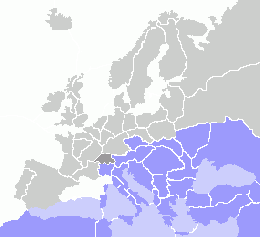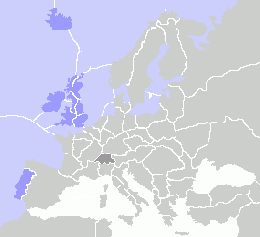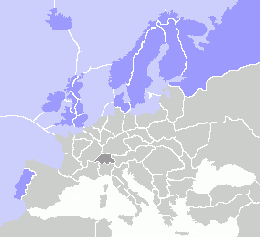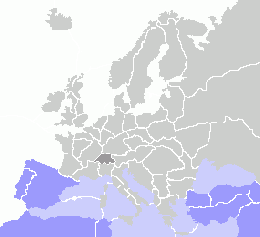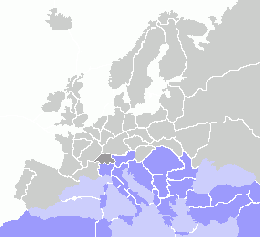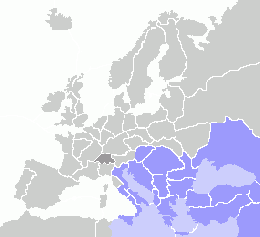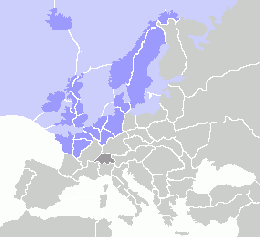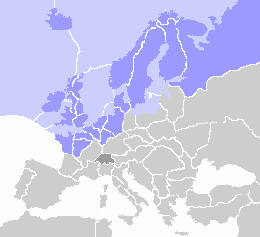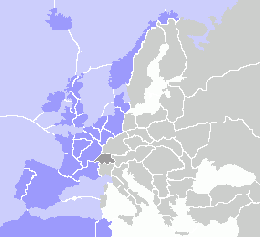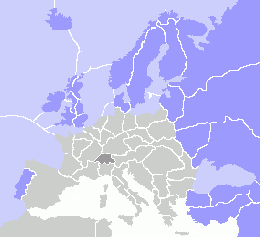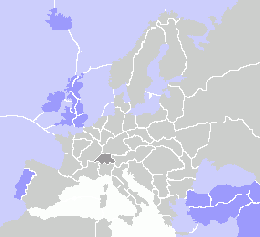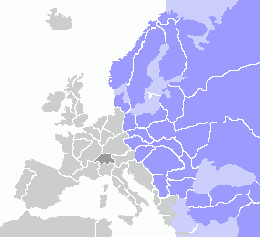Difference between revisions of "The Gamer's Guide To Diplomacy: Stalemates"
Former.trout (talk | contribs) |
Former.trout (talk | contribs) |
||
| Line 15: | Line 15: | ||
In many instances, the position will work whether a given unit is an army or fleet. In these cases, the abbreviation "U" (for "unit") will be used instead of "A" or "F". | In many instances, the position will work whether a given unit is an army or fleet. In these cases, the abbreviation "U" (for "unit") will be used instead of "A" or "F". | ||
| − | |||
| − | |||
===Position 1=== | ===Position 1=== | ||
| + | [[Image:Stalemate_1.gif|thumb|260 px]] | ||
Centers: | Centers: | ||
Turkey, Sevastapol, Balkans, Austria, Italy, Tunis. (15)<br> | Turkey, Sevastapol, Balkans, Austria, Italy, Tunis. (15)<br> | ||
| Line 37: | Line 36: | ||
''((Eric Verheiden's <u>"Minimal Southern Stalemate Positions"</u> outlines six 13-unit variations on this position that still hold all of Italy. --- Matthew Self, The Diplomatic Pouch (December 1995).)) '' | ''((Eric Verheiden's <u>"Minimal Southern Stalemate Positions"</u> outlines six 13-unit variations on this position that still hold all of Italy. --- Matthew Self, The Diplomatic Pouch (December 1995).)) '' | ||
| − | |||
===Position 1a=== | ===Position 1a=== | ||
| + | [[Image:Stalemate_Line_1a.gif|thumb|260 px]] | ||
A variant of this position requires only 3 fleets: | A variant of this position requires only 3 fleets: | ||
| Line 58: | Line 57: | ||
''((See John Beshera's <u>"Fundamental Stalemate Positions, III"</u> for many of these variations. --- Matthew Self, The Diplomatic Pouch (December 1995).)) | ''((See John Beshera's <u>"Fundamental Stalemate Positions, III"</u> for many of these variations. --- Matthew Self, The Diplomatic Pouch (December 1995).)) | ||
| − | |||
===Position 2=== | ===Position 2=== | ||
| + | [[Image:Stalemate_Line_2.gif|thumb|260 px]] | ||
* F Mid H | * F Mid H | ||
* F Por S Mid | * F Por S Mid | ||
| Line 70: | Line 69: | ||
England (or a Power that holds England) can maintain this position indefinitely under certain circumstances. The enemy must be a Southern Power (Austria, Italy, or Turkey). The Atlantic Powers (France, Germany, Russia) have been eliminated or are allied. It is not impossible to see a game stalemated like this: Assume, for instance, two Southern Powers have overrun the board. Their armies occupy all of Europe. However, their fleets are bottled inside the Mediterranean and they can't get out. They hold 30 centers (15 each or perhaps 14-16 or 13-17). Neither can win without stabbing the other. This is a powerful negotiating weapon in England's hands. | England (or a Power that holds England) can maintain this position indefinitely under certain circumstances. The enemy must be a Southern Power (Austria, Italy, or Turkey). The Atlantic Powers (France, Germany, Russia) have been eliminated or are allied. It is not impossible to see a game stalemated like this: Assume, for instance, two Southern Powers have overrun the board. Their armies occupy all of Europe. However, their fleets are bottled inside the Mediterranean and they can't get out. They hold 30 centers (15 each or perhaps 14-16 or 13-17). Neither can win without stabbing the other. This is a powerful negotiating weapon in England's hands. | ||
| − | + | ||
| + | |||
| + | |||
| + | <br> | ||
| + | <br> | ||
===Position 2a=== | ===Position 2a=== | ||
| + | |||
| + | [[Image:Stalemate_Line_2a.gif|thumb|260 px]] | ||
In a variant of this position, England can hold 8 centers with 6 units. Here Russia may still be in the game, so long as she has no fleets in the North. In the South, the set-up is as in Position 2. In the North: | In a variant of this position, England can hold 8 centers with 6 units. Here Russia may still be in the game, so long as she has no fleets in the North. In the South, the set-up is as in Position 2. In the North: | ||
| Line 85: | Line 90: | ||
| − | + | <br> | |
| + | <br> | ||
| + | |||
===Position 3=== | ===Position 3=== | ||
| + | |||
| + | [[Image:Stalemate_Line_3.gif|thumb|260 px]] | ||
* U Arm H | * U Arm H | ||
| Line 100: | Line 109: | ||
''((See Robert Bryan Lipton's <u>"A Series of Progressive Southern Stalemate Positions"</u> for a full development of this progression up the Italian peninsula and into Austria. Several of the positions hold Marseilles and Trieste, so the enemy alliance could potentially include an active France or Austria. --- Matthew Self, The Diplomatic Pouch (December 1995).)) '' | ''((See Robert Bryan Lipton's <u>"A Series of Progressive Southern Stalemate Positions"</u> for a full development of this progression up the Italian peninsula and into Austria. Several of the positions hold Marseilles and Trieste, so the enemy alliance could potentially include an active France or Austria. --- Matthew Self, The Diplomatic Pouch (December 1995).)) '' | ||
| + | |||
| + | <br> | ||
===Position 4=== | ===Position 4=== | ||
| − | U Arm H | + | [[Image:Stalemate_Line_4.gif|thumb|260 px]] |
| + | |||
| + | * U Arm H | ||
| + | * U Rum H | ||
| + | * U Bul(ec) S Rum | ||
| + | * F Bla S Rum | ||
| + | * A Bud H | ||
| + | * A Ser S Bud | ||
| + | * A Trl H | ||
| + | * A Tri S Trl | ||
| + | * A Ven S Trl | ||
| + | * F Wes H | ||
| + | * F NAf S Wes | ||
| + | * F Lyo H | ||
| + | * F Pie S Lyo | ||
| + | |||
This is Position 1 reduced to 13 centers (Italy, Turkey, Balkans, Tri, Bud, Tun). There are variants in which Vie or Sev could be added for 14 centers, and one which adds both and omits Tun. | This is Position 1 reduced to 13 centers (Italy, Turkey, Balkans, Tri, Bud, Tun). There are variants in which Vie or Sev could be added for 14 centers, and one which adds both and omits Tun. | ||
| − | ((Eric Verheiden's "Minimal Southern Stalemate Positions" examines these and other variations on this theme. --- Matthew Self, The Diplomatic Pouch (December 1995).)) | + | ''((Eric Verheiden's <u>"Minimal Southern Stalemate Positions"</u> examines these and other variations on this theme. --- Matthew Self, The Diplomatic Pouch (December 1995).))'' |
| + | |||
In the last case, the position around Italy becomes: | In the last case, the position around Italy becomes: | ||
| + | |||
===Position 4a=== | ===Position 4a=== | ||
| + | |||
| + | [[Image:Stalemate_Line_4a.gif|thumb|260 px]] | ||
F Ion H, F Gre S Ion, U Rom H, U Nap S Rom, U Ven H, U Apu S Ven, F Adr S Ven. | F Ion H, F Gre S Ion, U Rom H, U Nap S Rom, U Ven H, U Apu S Ven, F Adr S Ven. | ||
| Line 118: | Line 148: | ||
===Position 5=== | ===Position 5=== | ||
| + | |||
| + | [[Image:Stalemate_Line_5.gif|thumb|260 px]] | ||
U Nwy H, U Swe S Nwy, F NAt H, F Iri H, U Bre H, F Eng S Bre, A Bur H, A Par S Bur, A Bel S Bur, U Kie H, A Ruh S Kie. | U Nwy H, U Swe S Nwy, F NAt H, F Iri H, U Bre H, F Eng S Bre, A Bur H, A Par S Bur, A Bel S Bur, U Kie H, A Ruh S Kie. | ||
| Line 124: | Line 156: | ||
===Position 5a=== | ===Position 5a=== | ||
| + | |||
| + | [[Image:Stalemate_Line_5a.gif|thumb|260 px]] | ||
If Russia is still active, there is an 11-unit position that holds 12 centers. Remove U Swe and add U StP. Then: | If Russia is still active, there is an 11-unit position that holds 12 centers. Remove U Swe and add U StP. Then: | ||
| Line 134: | Line 168: | ||
===Position 5b=== | ===Position 5b=== | ||
| + | |||
| + | [[Image:Stalemate_Line_5b.gif|thumb|260 px]] | ||
U Nwy H, F Bar S Nwy, F Ska S Nwy, U Kie H, U Hol S Kie, A Ruh S Kie, U Den H, F Hel S Den, A Bur H, F Lyo H, F Mar S Lyo, F Wes S Lyo, U Tun H, U NAf S Tun. | U Nwy H, F Bar S Nwy, F Ska S Nwy, U Kie H, U Hol S Kie, A Ruh S Kie, U Den H, F Hel S Den, A Bur H, F Lyo H, F Mar S Lyo, F Wes S Lyo, U Tun H, U NAf S Tun. | ||
| Line 142: | Line 178: | ||
===Position 6=== | ===Position 6=== | ||
| + | |||
| + | [[Image:Stalemate_Line_6.gif|thumb|260 px]] | ||
U Den H, U StP(sc) S Lvn, F Mid H, F Por S Mid, F NAt (or Iri or Eng) S Mid, U Con H, F Bla (or U Ank) S Con, U Syr H, U Smy S Smy, A Ukr H, A Mos S Ukr, A Sev S Ukr. | U Den H, U StP(sc) S Lvn, F Mid H, F Por S Mid, F NAt (or Iri or Eng) S Mid, U Con H, F Bla (or U Ank) S Con, U Syr H, U Smy S Smy, A Ukr H, A Mos S Ukr, A Sev S Ukr. | ||
| Line 150: | Line 188: | ||
===Position 6a=== | ===Position 6a=== | ||
| + | |||
| + | [[Image:Stalemate_Line_6a.gif|thumb|260 px]] | ||
F Mid H, F Por S Mid, F NAt (or Iri or Eng) S Mid, F Aeg H, F Con S Aeg, F Eas S Aeg, U Arm H. | F Mid H, F Por S Mid, F NAt (or Iri or Eng) S Mid, F Aeg H, F Con S Aeg, F Eas S Aeg, U Arm H. | ||
This is the minimum contraction of Position 6. One of the 4 Southern units is supplied by a center in the North. Although Russia is virtually the only Power which can achieve this configuration, it is now centered entirely on the two corner powers. Of course, there can be no fleets in the North nor in the Black Sea. (This means that the coalition Russia is facing would be Austria/Italy.) | This is the minimum contraction of Position 6. One of the 4 Southern units is supplied by a center in the North. Although Russia is virtually the only Power which can achieve this configuration, it is now centered entirely on the two corner powers. Of course, there can be no fleets in the North nor in the Black Sea. (This means that the coalition Russia is facing would be Austria/Italy.) | ||
| + | |||
| + | |||
| + | [[Image:Eas-1.gif|thumb|260 px]] | ||
| + | |||
((The only significant line not covered in this article is the Eastern line detailed in Eric Verheiden's "Eastern Stalemate Positions". These position use Turkey, Russia and Scandinavia as a base to expand into parts of Austria and Germany. These positions tend to be very large - all of the cataloged positions hold 16 or 17 centers. --- Matthew Self, The Diplomatic Pouch (December 1995).)) | ((The only significant line not covered in this article is the Eastern line detailed in Eric Verheiden's "Eastern Stalemate Positions". These position use Turkey, Russia and Scandinavia as a base to expand into parts of Austria and Germany. These positions tend to be very large - all of the cataloged positions hold 16 or 17 centers. --- Matthew Self, The Diplomatic Pouch (December 1995).)) | ||
The Use Of Stalemates | The Use Of Stalemates | ||
Revision as of 14:50, 29 March 2008
The Gamer's Guide To Diplomacy: Stalemates
by: Rod Walker
A stalemate is a position on the board which prevents any further advance by the enemy. A stalemate line is a line of units, none of which can be dislodged by any combination of opposing attacks and supports.
In the following commentary, a "stalemate line" is also defined as follows:
1. The line has not more than 17 units, holding not more than 17 centers (and not fewer centers than units).
2. The line is held by one or more players against an alliance of two or more players (who would then control 17 or more centers and units).
3. There are no enemy units behind the line and the enemy has no capacity for building any such unit.
The first known stalemate positions were published in Wild 'n Woolly in 1966. Since that time, several dozen such lines have been discovered and published. Six basic positions and some of their variants are discussed below.
In many instances, the position will work whether a given unit is an army or fleet. In these cases, the abbreviation "U" (for "unit") will be used instead of "A" or "F".
Position 1
Centers:
Turkey, Sevastapol, Balkans, Austria, Italy, Tunis. (15)
Units:
A Sev, A Ukr, A Gal, A Bud (or Vie or Rum), A Boh, A Trl, F Pie, F Lyo, F Wes, F NAf. (10)
Orders:
- A Sev S Ukr
- A Bud S Gal
- A Trl S Boh
- F Pie S Lyo
- F NAf S Wes.
Discovered by Conrad von Metzke in 1966, this position uses only 10 units to hold nearly half the board (15 centers). The army in Budapest could just as easily be in Vienna or Rumania. However, to reduce the number of centers covered requires, paradoxically, an increase in the number of units. There are some 13- and 14-unit positions which can be held. (See Position 4 below.)
((Eric Verheiden's "Minimal Southern Stalemate Positions" outlines six 13-unit variations on this position that still hold all of Italy. --- Matthew Self, The Diplomatic Pouch (December 1995).))
Position 1a
A variant of this position requires only 3 fleets:
F NAf, F Wes, and F TyS. F Pie becomes A Pie; and we must add A Tus. The revised orders for this portion of the line:
- F Wes H
- F NAf S Wes
- F TyS S Wes
- A Pie H
- A Tus S Pie
Here 11 units still hold 15 centers.
In these positions, the East holds all of Italy. It has been asserted that an Eastern stalemate is impossible without all of Italy (John Beshera, 1971), but that is a mistake. Karl Pettis and others have since noted positions holding only part of Italy; there are possible stalemate lines holding only Venice, or only Naples, or Venice/Rome, Naples/Rome, or even Venice/Naples. (See Position 6 for an Eastern stalemate which holds no Italian centers at all.)
((See John Beshera's "Fundamental Stalemate Positions, III" for many of these variations. --- Matthew Self, The Diplomatic Pouch (December 1995).))
Position 2
- F Mid H
- F Por S Mid
- F NAt S Mid.
This was first noted by John McCallum in 1966. It uses three units to blockade the exit from the Mediterranean. It holds four centers (England & Portugal). F NAt could be Iri or Eng.
England (or a Power that holds England) can maintain this position indefinitely under certain circumstances. The enemy must be a Southern Power (Austria, Italy, or Turkey). The Atlantic Powers (France, Germany, Russia) have been eliminated or are allied. It is not impossible to see a game stalemated like this: Assume, for instance, two Southern Powers have overrun the board. Their armies occupy all of Europe. However, their fleets are bottled inside the Mediterranean and they can't get out. They hold 30 centers (15 each or perhaps 14-16 or 13-17). Neither can win without stabbing the other. This is a powerful negotiating weapon in England's hands.
Position 2a
In a variant of this position, England can hold 8 centers with 6 units. Here Russia may still be in the game, so long as she has no fleets in the North. In the South, the set-up is as in Position 2. In the North:
- U Den H
- U StP H
- F Bar S StP.
This position leaves England with two extra units with which to harass the enemy, contemplate expansion, or take advantage of stabs on the other side. It can be expanded to include France, Iberia, Belgium, Holland, and parts of Germany. A large number of resulting positions cover 14 to 16 centers. Many of these take into account enemy fleets in the North. (See Position 5b for an example.)
((See Robert Bryan Lipton's "A Series of Progressive Northern Stalemate Positions" for a full development of this progression to 17 centers. --- Matthew Self, The Diplomatic Pouch (December 1995).))
Position 3
- U Arm H
- U Con H
- U NAf H
- U Spa H
- U Por S Spa
- F Wes S Spa.
This unusual position holds 6 centers (Turkey, Iberia, Tunis). The enemy is presumably an Anglo-German alliance that has swept the rest of the board. It will not hold if there is an enemy fleet in the Black Sea or the Mediterranean.
((See Robert Bryan Lipton's "A Series of Progressive Southern Stalemate Positions" for a full development of this progression up the Italian peninsula and into Austria. Several of the positions hold Marseilles and Trieste, so the enemy alliance could potentially include an active France or Austria. --- Matthew Self, The Diplomatic Pouch (December 1995).))
Position 4
- U Arm H
- U Rum H
- U Bul(ec) S Rum
- F Bla S Rum
- A Bud H
- A Ser S Bud
- A Trl H
- A Tri S Trl
- A Ven S Trl
- F Wes H
- F NAf S Wes
- F Lyo H
- F Pie S Lyo
This is Position 1 reduced to 13 centers (Italy, Turkey, Balkans, Tri, Bud, Tun). There are variants in which Vie or Sev could be added for 14 centers, and one which adds both and omits Tun.
((Eric Verheiden's "Minimal Southern Stalemate Positions" examines these and other variations on this theme. --- Matthew Self, The Diplomatic Pouch (December 1995).))
In the last case, the position around Italy becomes:
Position 4a
F Ion H, F Gre S Ion, U Rom H, U Nap S Rom, U Ven H, U Apu S Ven, F Adr S Ven. With a few adjustments, including U Ven S Tri, the Eastern power could hold Vienna and Budapest without holding Tyrolia, Bohemia or Galicia.
((See Part II of Robert Bryan Lipton's "A Series of Progressive Southern Stalemate Positions" for more details on this position. John Beshera's "Fundamental Stalemate Positions, III" details related positions which hold only parts of Italy, but which expand into Russia and Germany. --- Matthew Self, The Diplomatic Pouch (December 1995).))
Position 5
U Nwy H, U Swe S Nwy, F NAt H, F Iri H, U Bre H, F Eng S Bre, A Bur H, A Par S Bur, A Bel S Bur, U Kie H, A Ruh S Kie. This position holds 11 centers against any Southern power. There can be no enemy fleets in the North, which means that Russia has been eliminated.
Position 5a
If Russia is still active, there is an 11-unit position that holds 12 centers. Remove U Swe and add U StP. Then:
U StP H, U Nwy S StP. There are several variations of this position.
((See Eric Verheiden's "Northern Stalemate Positions" for more variations, including extensions into Russia. --- Matthew Self, The Diplomatic Pouch (December 1995).))
Position 5b
U Nwy H, F Bar S Nwy, F Ska S Nwy, U Kie H, U Hol S Kie, A Ruh S Kie, U Den H, F Hel S Den, A Bur H, F Lyo H, F Mar S Lyo, F Wes S Lyo, U Tun H, U NAf S Tun. This typical Northern position holds 14 centers. The opposition could have fleets in StP, Swe, Bal, and/or Ber without being able to break out. Tunis must be held or the Mediterranean would eventually be lost. Variants of this position run up to 17 centers.
((See Eric Verheiden's "Western Stalemate Positions" for numerous variations, including extensions into Italy. --- Matthew Self, The Diplomatic Pouch (December 1995).))
Position 6
U Den H, U StP(sc) S Lvn, F Mid H, F Por S Mid, F NAt (or Iri or Eng) S Mid, U Con H, F Bla (or U Ank) S Con, U Syr H, U Smy S Smy, A Ukr H, A Mos S Ukr, A Sev S Ukr. This position is one in which Russia (minus Warsaw) can stalemate with 13 centers. Russia is the one Power which could eliminate both England and Turkey and have fleets in both North and South: an essential prerequisite for this position. This could also expand (into Warsaw or Bulgaria and Rumania), or it could contract in a number of ways.
((See Robert Bryan Lipton's "A Progressive Series of Asymmetrical Stalemate Positions" for a full development of the variations. --- Matthew Self, The Diplomatic Pouch (December 1995).))
Position 6a
F Mid H, F Por S Mid, F NAt (or Iri or Eng) S Mid, F Aeg H, F Con S Aeg, F Eas S Aeg, U Arm H. This is the minimum contraction of Position 6. One of the 4 Southern units is supplied by a center in the North. Although Russia is virtually the only Power which can achieve this configuration, it is now centered entirely on the two corner powers. Of course, there can be no fleets in the North nor in the Black Sea. (This means that the coalition Russia is facing would be Austria/Italy.)
((The only significant line not covered in this article is the Eastern line detailed in Eric Verheiden's "Eastern Stalemate Positions". These position use Turkey, Russia and Scandinavia as a base to expand into parts of Austria and Germany. These positions tend to be very large - all of the cataloged positions hold 16 or 17 centers. --- Matthew Self, The Diplomatic Pouch (December 1995).)) The Use Of Stalemates
List of stalemate positions are tedious reading, at best. One is tempted to ask, what good is all this? The answer may be that a stalemate is the best alternative if you can't win or maybe it isn't. Every individual game develops its own character. A player's decision as to whether he is even interested in a stalemate depends on how he feels about the game as a whole and about the other players. Perhaps he will prefer to come in second. Perhaps he will even prefer to be eliminated in order to help achieve a particular result. It is silly to insist that there is any single "best" goal in Diplomacy. Everyone has his own priorities and trying to fit them all into one's own mold is small-minded.
However, an awareness of potential stalemate lines is essential to strong play, especially in a tournament setting or postal play. A stalemate line is a powerful position and the threat of a stalemate is a potent diplomatic weapon. On one hand, a winning alliance can be broken up by an opposition which can force a stalemate.
On the other hand, a small power can use her stalemate position to bargain with the others. A strategic situation may often mean achievement of stalemate to one side and breakthrough to the other. Each should be willing to pay a high price for an alliance. A small power which controls the key position may be able to bargain quite well for herself.
Stalemates are frequently hard to arrange and are often tactically complex (if an alliance is involved on the defensive side). For these reasons, players may be tempted to spend more time on them than they are worth. A stalemate is, after all, a sort of last refuge. It is the final resort of a large power that can't win or of one or more players who can't stop an impending victory any other way.
Compared to a free-wheeling game where the situation is flexible, a stalemate is dull and uninteresting. Most drawn games come about because one faction has become "entrenched". In the final analysis, it represents the ultimate failure and breakdown of diplomacy. Still, a stalemate is sometimes better than any available alternative. An alter Diplomacy player should be ready to use his knowledge of stalemates whenever necessary.
Reprinted from The Gamer's Guide To Diplomacy, 2nd edition (March 1979).
Adapted for Dipwiki from The Diplomatic Pouch

